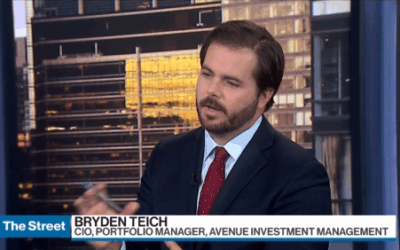When we at Avenue make an investment, we are deciding to buy and hopefully hold with a view to compound in a business for as long as we can. This is why we search for important traits like profitability, fair valuation and predictability of the underlying business model. We are not hopping from trend to trend.
We can use examples from this current bull market in technology to highlight the type of predictability we are looking for. From today’s perspective it might seem obvious that Artificial Intelligence (AI) would come to dominate investor psychology, but this was not the case even a few years ago. During COVID, the reality was that our conversations with clients were often about their desire to move money to private equity and not invest in the major technology companies. Amazingly, it only took a few years for the private equity trend to wane as investment returns have stalled, and many funds have frozen redemptions.
First, we would like to give a couple of examples, from recent investments, of what we like in terms of predictability. Medpace Holdings (MEDP) is a business we purchased in July. They run lab trials for biotechnology companies. We very well might be living in the golden age of biotechnology, but startups are very risky, and the large ones are expensive, and patents expire. However, Medpace is the global leader in running biotech trials, is super consistent, growing gradually and is diversified with a global footprint of labs.
We have also recently invested in Pembina Pipeline (PPL) which is a Western Canadian energy infrastructure company. The business has profitable long-term pipeline contracts and conservatively finances their growth projects. We will have growing exposure to liquified natural gas exports and natural gas power for data centres for the next decade.
The commonality of Avenue’s two investments above is that we understand what these businesses are doing, and we can follow their development. However, we get concerned if investments start doing something that is not in their core competency. On the following page we will discuss major technological businesses that are much less predictable. Many investors like to say they are investing in the future, but we think a more accurate summary of today’s big tech investment strategy is more like this.
“I would like to own what everyone one else owns, and I don’t care what I pay for it. As well, I’m not sure what they will be doing in the future, but I trust them to figure it out.”
Apple, only a short time ago, was the most valuable company in the world. However, Apple manufactures most of its products in China and thus has become a target for the American project of reshoring jobs. Tariffs of 100% were threatened on iPhones, then the following week they were retracted. Currently tariffs are 25% but anything could happen. Apple is the poster child for near-term unpredictability.
Meta’s business model is to make money by selling users’ behaviour to other companies so they can pay Meta to send ‘target advertising’ to the users of Facebook and Instagram. The European Union is looking at giving users the option for data privacy. Also, Meta recently took action to sue Brazil for the introduction of PIX, a national digital payment system where the user is not tracked. Hopefully a data privacy system will come to Canada. If there is a movement to limit tracking of user behaviour, Meta’s profitability is in real trouble. Not knowing how data will be stored and shared is a real medium-term risk for Meta.
Amazon is an amazing creation which allows us to buy online items for home delivery, sometimes the same day. However, much of their recent growth has come from their cloud business called Amazon Web Services (AWS). In the race to dominate AI computing, AWS is losing out to Microsoft and Oracle. The point here is that the technology race to dominate AI will have very unpredictable winners and losers. Who even knew Oracle was in the race to outpace AWS until a month ago?
NVIDIA is now the most valuable company on earth at $4.5 trillion and makes a significant amount of money. Cash flow is getting close to $100 billion, and on its way to $200 billion annually if AI chip demand holds up. The company has a 65% profit margin, and the chips are second to none for running AI large language models.
To have made an investment in NVIDIA a year ago or even two years ago, our analysis would have to have been that in the future there must absolutely be an AI investment frenzy to justify the valuation of the stock. Also, our analysis would have needed to conclude that every chip designer and manufacturer would be trying to copy the NVIDIA chip, yet NVIDIA would maintain their industry leadership. The leadership is dominant for now but five years out it gets less certain. For example, China, which is the second largest market for AI, has just banned the use of high-end NVIDIA chips to encourage domestic market chip innovation.
Then along comes the evolution taken from the Asian playbook called ‘circular holdings’. NVIDIA has made a $12 billion investment in the data centre company CoreWeave. Here NVIDIA is both a supplier of chips and a customer of the data centre. It is good business to make sure your customer has money to invest in your chips. This was such a good idea that NVIDIA has made a $100 billion investment in OpenAI. These cross holdings will make it very difficult to predict who will make what money from whom in the future.
The graphic below does an excellent job of highlighting the cross financing and inter relationships between all the major AI companies.

OpenAI started the AI race when they launched ChatGPT in 2023 and is actively working to maintain its central position. While OpenAI is not a public stock, it is described as a ‘hybrid not-for-profit’ company with a private market valuation of $500 billion. This is where it gets fun. OpenAI has made commitments to invest $500 billion into NVIDIA, $300 billion into Oracle and $300 billion into AMD (Advanced Micro Devices). The AMD investment is to secure 20 gigawatts of computing capacity. This is equivalent to 20 nuclear reactors where each gigawatt of capacity costs $50 billion. To reiterate, Open AI is investing $1.1 trillion. This is a company that is valued at $500 billion and will lose $10 billion this year. Also, Open AI has borrowed $47 billion using their NVIDIA chips as collateral. The value of these chips will depreciate at some point.
If this doesn’t sound bewildering, Elon Musk is in a knockout feud with Sam Altman, the CEO of OpenAI. Elon Musk has committed everything in his power using xAI to put OpenAI out of business.
Avenue’s investment strategy is to buy and hold high quality businesses where we don’t have to trade the latest trend. We need to have predictability in the underlying businesses where we have a good idea of what our companies will be doing 5 and even 10 years from now.



